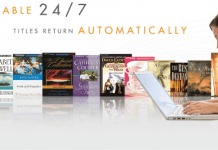
Both at LibraryJournal.com and LibraryCity.org, I’ve reminded the Digital Public Library of America that it needs to serve public library users well, not just the academic variety.
That’s been my goal since the early 1990s when I first proposed a national digital library system well integrated with local schools and public libraries. Nowadays I actually favor two separate but tightly intertwined systems, one public, one academic, since many of their priorities so starkly differ.
Over the weekend, the Washington Post published a must-read for DPLA leaders and others: As demand for e-books soars, libraries struggle to stock their virtual shelves.
“Want to take out the new John Grisham?” wrote Staff Writer Christian Davenport. “Get in line. As of Friday morning, 288 people were ahead of you in the Fairfax County Public Library system, waiting for one of 43 copies. You’d be the 268th person waiting for “The Girl With the Dragon Tattoo,” with 47 copies. And the Steve Jobs biography? Forget it. The publisher, Simon & Schuster, doesn’t make any of its digital titles available to libraries.” As I write this, the e-book piece is the most popular local article on the Washington Post Web site.
Here’s my very friendly suggestion for the DPLA. Get hopping on this issue before others—either OverDrive, 3M, other private companies, or rival nonprofits—preempt you. The DPLA already knows about it. But now the media and public are starting to wake up.
The DPLA Technical Aspects Workstream should schedule a special session ASAP to correct the so-far-glaring deficiencies in the contemplated services for public libraries and schools. The Audience and Participation session set for February in Dallas, and limited to only 20 or so participants in person, isn’t enough. Same for the Content and Scope Workstream, also holding a session soon. E-library suggestions are meaningless without a good technological vision. I’d like to see public and academic library systems share not just gig after gig of content but also a common technical organization that could address issues ranging from servers and archiving to end-user hardware and connectivity alliances. Ideally I could be at all the related sessions to discuss the relevant details in two recent LibraryCity essays: Toward an e-library ecosystem: Public libraries will screw themselves if they don’t learn from Amazon’s comprehensive ‘seamless’ approach and The hotspot strategy: Cost-justifying free tablet computers for low-income library users.
At least one leader of the DPLA Tech Workstream has already read the WaPo article (and earlier acknowledged that there was more to be done in the public library area), and you can bet I’ll be forwarding the Web address of this LibraryCity post to him and to people with A&P and Content and Scope. I would much rather that the DPLA remove “Public” from its name, so as not to harm the franchise and branding of brick-and-mortar public libraries. But the DPLA’s baffling insistence on the P Word—regardless of the negative reaction last spring from the Chief Officers of State Library Agencies—is all the more reason for the DPLA to act. I’d really like for the DPLA to succeed. More attention paid to public library needs would help both library-users and this worthy organization.
Similar Posts:
- For ALL—rural and urban, rich and poor
- DPLA now considering separate academic and public library systems, and meanwhile the first Beta Sprint deadline is nearing—June 15
- National Digital Public Library conference: A little progress toward a two-system approach—to help both public and academic libraries?
- National digital libraries should be for ALL, says Europeana executive director—not just academics
- DPLA still clinging to ‘Public’ in name—despite risks to the franchise and branding of America’s public libraries
[Via LibraryCity]


































I quote: “Want to take out the new John Grisham?” wrote Staff Writer Christian Davenport. “Get in line. As of Friday morning, 288 people were ahead of you in the Fairfax County Public Library system, waiting for one of 43 copies.
What is John Gresham’s publisher thinking or, more accurately is it thinking at all? In a supermarket, when the line of customers gets that long, they call more staff to the front. And if it’s chronically that long, they add new cash registers. Customers and readers shouldn’t be kept waiting.
The Buy to Loan business model that we’re talking about here is the only publisher-to-library model that works for printed books. But it’s far from the only model for digital books, much less the best one.
Far better is a model that has unlimited shelf-space, meaning every ebook a publisher has is made available to every willing library. Then the one room of Fleahop Community Library’s collection the becomes as large as that of the New York Public Library. Every ebook available to virtually everyone living in the U.S. What sensible publisher wouldn’t want that kind of distribution, particularly since there are no returns?
Marry that with a Rent to Read business model. Libraries wouldn’t pay to buy an ebook. They’d pay a smaller rental fee every time an ebook is checked out or renewed. Little know ebooks, ebooks that almost no library would buy, earn income. And popular titles earn money very quickly.
What are these publishers thinking? Success in business often hinges on one key individual discovering a new business idea. Practically giving away the safety razor body and making money on the blades was one such discovery. It made Gillette a huge and successful business.
Rent to Read is another. When you’ve got a product that costs virtually nothing to reproduce in unlimited quantities, that costs almost nothing to distribute, and that never wears out, why wouldn’t you want to rent rather than sell, particularly when the number of rentals are going to be far greater than the sales will every be?
Yes, I know that in today’s market the major book publishers are very risk adversative. But you would think that at least one publisher would join with at least one author to test this business model. Let every John Gresham fan get his latest book within hours rather than waiting months for their turn and see what the result is.
Right now publishers are fixated on protecting the price structure of the physical book market. As long as this is true they won’t consider any innovative way to price or distribute ebooks.
The same thing happened with music. When digital music became popular the big studios could think of nothing except how to protect CD sales. But once digital music became the dominant format everything shifted and new modes of distribution arose.
Michael: I’m in favor of experimentation with different business models, and as far as decreasing fees for checkouts of the most popular titles, I was calling for this back in the 1990s. E scales up different from P. Whatever the model, the goal should be to multiply the number of titles available to the typical library patron while fairly paying publishers. This is one reason content providers and libraries should spend less time on the copyright wars and more time lobbying together for higher library appropriations at all levels of government.
Binko: Yes, the big p-publishers are very very protective of their current biz models and their paper-based businesses. But the more common e-readers become, the less leverage the huge p-fixated houses will enjoy, especially with more possibilities for small publishers. Meanwhile, as I keep saying, libraries should strive for more power by way of a robust ecosystem (http://librarycity.org/?p=3161). Both libraries and publishers would come out ahead with more library influence. Stable links, for example, would add to the value of networked books from publishers.
Thanks,
David